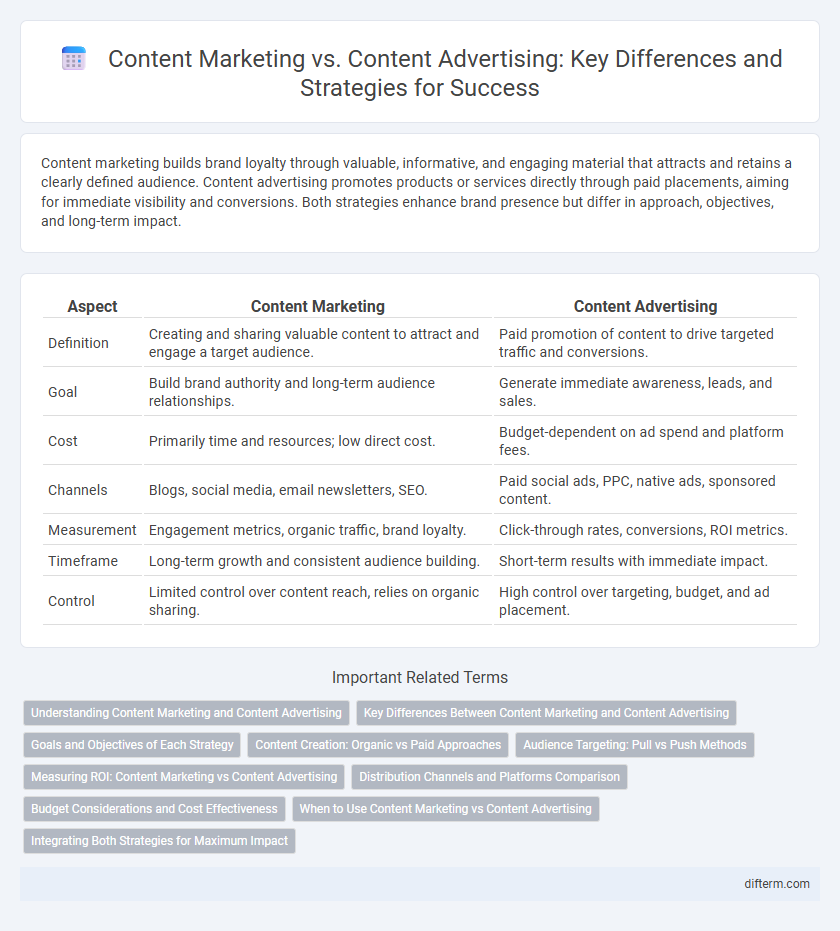Content marketing builds brand loyalty through valuable, informative, and engaging material that attracts and retains a clearly defined audience. Content advertising promotes products or services directly through paid placements, aiming for immediate visibility and conversions. Both strategies enhance brand presence but differ in approach, objectives, and long-term impact.
Table of Comparison
| Aspect | Content Marketing | Content Advertising |
|---|---|---|
| Definition | Creating and sharing valuable content to attract and engage a target audience. | Paid promotion of content to drive targeted traffic and conversions. |
| Goal | Build brand authority and long-term audience relationships. | Generate immediate awareness, leads, and sales. |
| Cost | Primarily time and resources; low direct cost. | Budget-dependent on ad spend and platform fees. |
| Channels | Blogs, social media, email newsletters, SEO. | Paid social ads, PPC, native ads, sponsored content. |
| Measurement | Engagement metrics, organic traffic, brand loyalty. | Click-through rates, conversions, ROI metrics. |
| Timeframe | Long-term growth and consistent audience building. | Short-term results with immediate impact. |
| Control | Limited control over content reach, relies on organic sharing. | High control over targeting, budget, and ad placement. |
Understanding Content Marketing and Content Advertising
Content marketing focuses on creating valuable, relevant content to attract and engage a target audience over time, building trust and brand loyalty. Content advertising involves paid promotion of content to increase visibility and drive immediate traffic or conversions through targeted ads. Both strategies complement each other by blending organic engagement with paid reach for comprehensive marketing success.
Key Differences Between Content Marketing and Content Advertising
Content marketing focuses on creating valuable, relevant, and consistent content to attract and engage a targeted audience, driving long-term brand loyalty and organic growth. Content advertising involves paid promotions designed to boost visibility and immediate engagement through targeted ads on platforms like social media, search engines, and display networks. The key differences lie in ownership, cost structures, goals, and interaction strategies, with content marketing emphasizing relationship-building and content advertising prioritizing quick conversions.
Goals and Objectives of Each Strategy
Content marketing aims to build long-term brand awareness and trust by creating valuable, relevant, and consistent content that nurtures audience engagement and loyalty. Content advertising focuses on driving immediate actions such as clicks, conversions, and sales through targeted paid campaigns designed to deliver measurable results quickly. Both strategies serve distinct business goals, with content marketing emphasizing relationship-building and content advertising prioritizing direct response and revenue generation.
Content Creation: Organic vs Paid Approaches
Content marketing emphasizes organic content creation aimed at building trust and long-term audience engagement through valuable, informative materials such as blogs, videos, and social media posts. Content advertising relies on paid approaches to amplify content reach quickly, using targeted ads and sponsored posts to drive immediate traffic and conversions. Effective marketing strategies balance organic content development with paid advertising to maximize visibility and foster sustained customer relationships.
Audience Targeting: Pull vs Push Methods
Content marketing employs pull methods by attracting audiences through valuable, informative content tailored to their interests and needs, fostering long-term engagement and brand loyalty. Content advertising uses push methods, delivering targeted ads directly to specific demographics via platforms like social media and search engines to generate immediate conversions. Effective audience targeting leverages data analytics and behavior insights to optimize content placement and maximize ROI in both strategies.
Measuring ROI: Content Marketing vs Content Advertising
Measuring ROI in content marketing involves tracking long-term engagement metrics such as organic traffic, social shares, and lead generation, emphasizing brand authority and customer loyalty growth. Content advertising ROI focuses on immediate performance indicators like click-through rates, conversion rates, and cost per acquisition, highlighting the effectiveness of paid campaigns in driving targeted actions. Combining analytics from both strategies allows marketers to optimize budget allocation and improve overall campaign performance by balancing sustained brand building with short-term sales impact.
Distribution Channels and Platforms Comparison
Content marketing leverages owned channels like blogs, email newsletters, and social media profiles to build long-term audience engagement by delivering valuable, relevant content. Content advertising relies on paid distribution platforms such as Google Ads, Facebook Ads, and sponsored posts to amplify reach and target specific demographics quickly. While content marketing emphasizes organic growth through consistent publishing on websites and social media, content advertising uses targeted placement on search engines and social networks to drive immediate traffic and conversions.
Budget Considerations and Cost Effectiveness
Content marketing typically requires a lower budget focused on creating valuable, long-term assets such as blog posts, videos, and infographics that drive organic traffic and engagement over time. Content advertising demands a higher and ongoing investment in paid promotions like social media ads, sponsored content, and pay-per-click campaigns to generate immediate visibility and conversions. Evaluating cost effectiveness depends on campaign goals, with content marketing offering sustainable ROI through brand authority, while content advertising delivers quick results suited for short-term objectives.
When to Use Content Marketing vs Content Advertising
Content marketing is most effective for building long-term brand authority and nurturing customer relationships through valuable, informative content such as blog posts, ebooks, and social media engagement. Content advertising delivers immediate results by promoting specific products or offers via paid channels like Google Ads and sponsored social media posts, ideal for driving quick conversions or event responses. Choosing between content marketing and content advertising depends on campaign goals: prioritize content marketing for sustained audience trust and content advertising for fast, targeted reach and measurable ROI.
Integrating Both Strategies for Maximum Impact
Content marketing builds brand authority through valuable, consistent content that nurtures long-term relationships, while content advertising uses paid promotion to amplify reach and target specific audiences quickly. Integrating both strategies allows businesses to leverage organic engagement from content marketing alongside the precision and scalability of paid campaigns. This combined approach maximizes visibility, drives higher conversion rates, and optimizes return on investment in digital marketing efforts.
Content marketing vs content advertising Infographic

 difterm.com
difterm.com